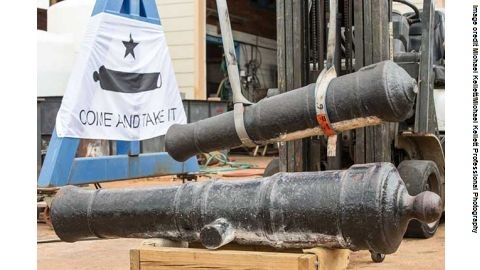
News release from Texas A&M:
The Conservation Research Laboratory on the RELLIS Education and Research Campus of Texas A&M University in Bryan is doing its part to help the world, “Remember the Alamo!”
Research Associate Jim Jobling and his team are conserving seven of the 21 cannons used during the Texas Revolution’s 1836 Battle of the Alamo as well as two others from the same time period.
All are displayed at the historic Alamo that is now a museum and popular tourist attraction in San Antonio. Two of the cannons were transported from the fort at the conclusion of Cannon Fest, a weekend-long event at the Alamo that explored the artillery of the Texas Revolution and announced the conservation of the cannons, and brought to Aggieland earlier this week. The other cannons are scheduled to arrive gradually over the coming months.
“Our efforts to preserve and protect the Alamo are first and foremost about the story of the battle itself. It was the 13 days of battle in 1836 that made this mission sacred,” said Texas General Land Office Commissioner George P. Bush to the crowd at Cannon Fest. “These cannons…sat on platforms of new wood on the perimeter of this fortress, trained on the enemy. Heroes died manning them. We need these cannons to last so future Texans can see 1836 for themselves.”
In the process of ensuring the cannons are around for future generations, the conservationists also are preserving one of the most inspiring moments in Texas history. Alamo Commander William Barret Travis and approximately 200 other Alamo defenders were greatly outnumbered by Santa Anna’s Mexican Army in 1836. While waiting on reinforcements that never arrived, all of them lost their lives defending their post during the legendary battle. Their bravery roused a spirit that spread among Texans, and “Remember the Alamo!” became a battle cry that helped them to defeat the Mexican troops, thereby winning the revolution.
“It’s about personal sacrifice, bravery, men who stood up for their beliefs,” Jobling said. “We want the cannon to last because they are a symbol of independence.”
The cannons, which were discovered in various locations near the Alamo between 1852 and 1908, have likely never been conserved, and have been buried under countless layers of paint over the years, Jobling said.
“We hope to find significant marks underneath all that paint that reveal the origins of the cannon,” Jobling said.
To stabilize the iron and remove the oxidation and corrosion, the conservationists will submerge each cannon in a vat of sodium hydroxide solution that will loosen and slough the thick paint while subjecting the artifact to an electrical current that will remove the corrosion. The process, called electrolysis, lasts approximately four weeks per cannon. Boiling rinses will clean the residual chemicals and salts from the surface, tannic acid will blacken the gun, and industrial-grade black paint will seal the surface of the artifact.
The historic cannons are named according to the weight of the shot they fired. The seven used during the Battle of the Alamo include two iron 3-pounders, two bronze 4-pounders, a three-quarter iron swivel, an iron 12-pounder gunnade and a 16-pounder, which is an unusual caliber. The two cannons from the same period not used during the battle include an iron 4-pounder and an iron 6-pounder. After conservation, the cannons will be returned to the Alamo for display.
The Alamo launched a GoFundMe campaign to raise $50,000 for the conservation project, and the Brown Foundation in Houston donated a lead gift of $7,000. Those interested in contributing to the cannon conservation and preservation of Texas history can visit the campaign website to learn more.
The Conservation Research Lab at Texas A&M was established by Director Donny Hamilton in 1978. Since then, the Lab has completed approximately 160 projects amounting to the conservation of about two million artifacts.
“The Lab enables about a dozen students each semester to gain hands-on experience,” Jobling said. “When they start their jobs, they can draw on actual experience conducting the conservation work, not just knowledge gained during classroom lectures.”

